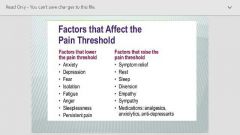![]()
![]()
![]()
Use LEFT and RIGHT arrow keys to navigate between flashcards;
Use UP and DOWN arrow keys to flip the card;
H to show hint;
A reads text to speech;
48 Cards in this Set
- Front
- Back
|
Biochemical mediators of pain |
The beginning and the agreement regarding specific functions is lacking |
|
|
Odontoblasts |
Sensory cells Receive and transfer stimuli to nerve endings in the pulp |
|
|
Hydrodynamic Theory |
it is necessary to show all stimuli that cause pain, the only sense experienced by the dental pulp, also cause fluid to flow in the dentinal tubules |
|
|
Algesic |
Pain giving chemical / Pain producing |
|
|
Hypertonic saline Potassium chloride 5-hydroxytryptamine Acetylcholine Bradykinin Histamine Substance P |
Pain producing substances |
|
|
Peptide bradykinin |
very potent and elicits the kind of pain that mimicked the clinically experienced sensation |
|
|
Chemoreceptors |
Sensory nerve endings that mediate pain |
|
|
Analgesic |
Pain relieving chemical/drug |
|
|
5-hydroxytryptamine Histamine Bradykinin |
Vasoactive amines |
|
|
Basophils Mast cells Platelets |
Main source of the amines |
|
|
Blood-clotting system |
Acts as the activator |
|
|
Kallikrein |
A protease, that liberates kinins from their precursors |
|
|
Prostaglandins |
Form a complex group of fatty acids |
|
|
To sensitize the nociceptors to the effects of bradykinin, thereby accentuating its action |
The main contribution of prostaglandins |
|
|
Aspirin Indomethacin Other minor analgesic agents |
Block the cyclooxygenase reaction by inactivating the enzyme, thereby preventing the biosynthesis of prostaglandin |
|
|
Substance P |
An excitatory transmitter within the nociceptive system at the first afferent synaptic level. May act as a modulator of neural excitability rather than as a neurotransmitter |
|
|
Naloxone |
Electrically induced analgesia was reversible by the narcotic antagonist |
|
|
Endorphins |
Morphine-like chemicals Morphin within Distribution of opoid receptors |
|
|
Abundance in the dorsal horn of the spinal cord Medullary raphe nuclei Periaqueductal gray matter |
Opoid receptors located |
|
|
Analgesia |
May be produced by closing the gate to noxious stimuli at the first synaptic level |
|
|
Pro-opiocortin |
A large polypeptide, is released by the pituitary gland and is the precursor fot both adrenal corticotropic hormone (ACTH) and B-lipoprotein |
|
|
B-lipoprotein |
Serves as the precursor for most endorphins such as b-endorphin, met-enkephalin, leu-enkephalin |
|
|
Analgesia Euphoria Catatonia Hallucinations Schizophrenia |
Neurohormones produce a wide variety of effects |
|
|
Pain perception |
Physioanatomical process whereby an impulse is generated |
|
|
Pain reaction |
Psychophysiological process that represents the individuals overt manifestation of the unpleasant perceptual process that just occured |
|
|
Hyporeactive |
High pain threshold |
|
|
Hyperreactive |
Low pain threshold |
|
|
Emotional States Age Fatigue Racial and nationality characteristics Sex Fear and apprehension |
Pain reaction |
|
|
Fifth cranial nerve or trigeminal nerve |
Is the principal sensory nerve of the head region |
|
|
Ascending fiber |
Conveys general tactile sensibility |
|
|
Descending fiber |
Conveys pain and temperature |
|
|
Physiological continuity |
Effected by synaptic transmission, which implies a relationship between two neurons without actual anatomical union |
|
|
Pain |
an unpleasant emotional experience usually initiated by a noxious stimulus and transmitted over a specialized neural network to the central nervous system where it is interpreted as such. |
|
|
Control or elimination of pain |
One of the most important aspects of the prcactice of dentistry |
|
|
Removing the cause Blocking the pathway in painful impulses Raising the pain threshold Preventing pain reaction by cortical depression Using psychosomtic methods |
Methods of Pain Control |
|
|
Removing the cause |
Desirable method of controlling pain |
|
|
Blocking the pathway of painful impulses |
The most widely used method in dentistry for controlling pain The local anestethic solution prevents depolarization of the nerve fibers Pain perception |
|
|
Raising the pain threshold |
Depends on the pharmacological action of drugs possessing analgesic properties. These drugs raise the pain threshold centrally and therefore interfere with pain reaction |
|
|
Aspirin |
Effectively only in the relief of mild discomfort |
|
|
Narcotics |
Not pure analgesics are effective against more severe pain because they are able to raise the pain threshold to a greater degree |
|
|
Preventing pain reaction by cortical depression |
Within the scope of general anesthesia and the general anesthetic agents Cerebral cortex is depressend only to the point that the inhinitions are suppressed, the patient may become hyperreactive to a painful stimulus |
|
|
Using psychosomatic methods |
Cheapest way to prevent pain Important factor: honesty & sincerity toward the patient |
|
|
Psychogenic pain |
Unpleasant sensation that has no organic basis. It is any pain that originates wholly whitin the mind and is fixed on some portion of the anatomy |
|
|
Referred Pain |
Pain experienced at a site some distance from the site of injury |
|
|
Neurogenic pain |
Sharp, burning and intense; may be constant or intermittent |
|
|
Vascular pain |
Diffuse; may be referred and thus difficult to localize |
|
|
Muscle pain |
Most likely dull; limited to the area of origin |
|
|
Factors |

|

